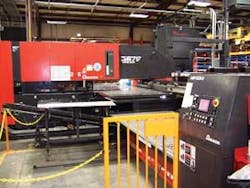Staying at the cutting edge
Laureen Belleville
The folks at Muza Metal Products (Oshkosh, WI; www.muzametal.com) make sure they stay focused on the challenges of tomorrow. That’s probably why they’ve been successful in business since 1928. The company’s early work included a significant amount of HVAC and sheet metal products, which then evolved into hard tool stamping. In the early 1980s it started focusing on soft tooling, using press brakes, turret, and shears. And that growth trend, including lasers, continues today.
“We bought our first laser back in 2000,” says Plant Manager Dan Hietpas. “There were things going on in the industry at that time that, we felt, in order to stay competitive we needed a laser.” Although the technology represented a big change for Muza, Hietpas says products that clients were bringing to the table necessitated the purchase.
Fortunately for Hietpas, he was familiar with the capabilities of laser systems-his previous employer had six of them. “I knew that the laser offered flexibility-cutting intricate contours and multi-part nesting capabilities-and automation. With turret, you’ve got to put all the tools in.” And the laser enables the company to cut heavier steel-up to 3/4-inch plate versus 1/4-inch plate with turret.
When Hietpas set out to find the right system he had determined that although speed wasn’t a huge issue, reliability was. The first unit Muza purchased was a Gemini 4000W flying optic laser from Amada America Inc. (Buena Park, CA; www.amada.com). The decision to buy from Amada was based partly on the recommendation of other users and partly on the fact that Muza already owned several other pieces of Amada equipment, including turret presses and press brakes. “I had a lot of Amada equipment already, so I knew that service was very good. And that was big for me,” notes Hietpas.
The company hasn’t looked back. It has since purchased a second Gemini 4kW unit with flying optic laser (and has another on order) and an Amada Apelio III 367V (see photo). The Apelio is a hydraulic punch laser combination machine that combines Amada’s original bridge frame design with the advantages of a high-speed punch press (33 tons) that can process 60- × 144-inch sheets with a single repositioning cycle. Its RF-excited, 2000W laser frees up turret stations for hardware insertions, high-quality forming, tapping, and other tools that eliminate secondary operations. Also, the software automatically selects the punch or laser for maximum machine utilization and minimum setup. An air spring cushion design isolates the laser optics from punching vibration.
Both the Gemini and Apelio systems are set up with the same 10-shelf tower that enables the users to feed material two ways-one way to the two lasers or the other way to the combination machine. For Muza, the Apelio offers the best of both worlds. “We have the whole thing covered with the combo and lasers,” explains Hietpas. “For parts that have extrusions or 3D work that a laser can’t do or a lot of holes, turret is still faster than laser. Yet, if a part has something contoured, it can go on to be laser cut.” The laser systems run 24/7 with one primary person creating nests and scheduling the work and four dedicated operators keeping the machines cutting.
The equipment purchase has affected production in a couple ways. Hietpas reports that the automation and system capabilities have increased Muza’s capacity exponentially and they have opened new markets that in the past it could not accommodate. “Without the ability to laser cut or handle capacity, there were several customers that we could not take care of before.” For example, a leading global manufacturer of hand and power tools approached Muza to laser cut the company’s logo onto some of its products. “This was a neat marketing tool for them, but there’s no way we could have done that with just the turret. And this is a significant account for us,” says Hietpas.
Furthermore, Hietpas notes that laser offers better material utilization-about 10 percent better than the turrets-because it is much easier to nest different parts together and utilize the entire material blank.
“When we first looked into the laser, it surprised me how far the technology had come in terms of speed and automation from back in the mid-1990s,” notes Hietpas. And for his staff-some 120 employees housed in an 80,000-square-foot facility-going from turret to laser represented a significant technology jump. Although Amada offered a significant amount of training up front, Hietpas says, “A lot of it is ‘learn as you go.’ And when issues come up, Amada comes in.”

